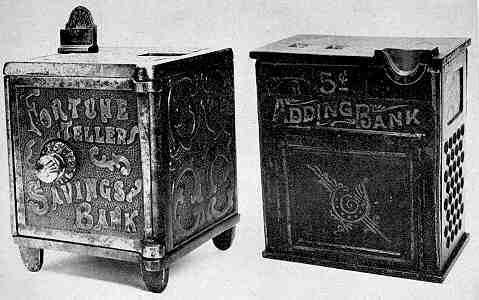Fortune Teller Savings Bank
5c Adding Bank
by F.H. Griffith - HOBBIES Magazine - December, 1968

A great number of toy savings banks were made in the form of a safe, but only three of the many different types fit into the mechanical bank category. These are the United States Bank (HOBBIES, August, 1956), the Watch Dog Safe, and the Fortune Teller Savings Bank, our choice as No. 166 in the numerical classification.
The Fortune Teller was patented February 19, 1901 by Aaron Kaufman of Baltimore, Md. He assigned the patent to Baumgarten & Company, also of Baltimore, and they manufactured the bank. The drawings accompanying the patent show the view window on the front of the safe door. For some reason this location was changed to the top in the production bank. Other than this, the bank as produced closely follows the patent and drawings with the exception of a separation plate inside the bank to protect the fortune wheel from the coins.
The bank shown, Figure 1, is in nice original condition with overall nickel plate finish. The fortune wheel inside the bank is made of tin with a printed paper of fortunes in color thereon. Strangely enough there are thirteen different fortunes on the wheel and these appear in sections of green, red, yellow, blue and black. The name is on the front door of the safe as shown in the photo. On the bottom of this bank is inscribed "Pat. Feb. 19, 1901." The writer has seen other specimens with just "Pat" on the bottom. He has also seen one with a very colorful paper label on the back, and for description of this please refer to HOBBIES article January, 1964. This example, by the way, had "Pat" on the bottom. It is not known to the writer if all examples of the Fortune Teller originally had paper labels on the back. It may well be that only those with "Pat" on the bottom originally had the paper label, however, it is the writer’s opinion the label was used on all Fortune Tellers. The plain back casting with the very decorative front and sides would logically indicate this.
To operate the bank a coin is dropped into the operating lever on top of the safe. The coin engages a toothed wheel and when the lever is pushed back the fortune wheel is caused to spin, stopping with one of the fortunes showing in the glass covered section on top. The coin disengages itself during the action and drops to the bottom of the bank. It is necessary to use a coin to operate the bank and, of course, this is a desirable feature. As with most safe type banks, coins are removed by means of a combination lock.
The 5c Adding Bank, Figure 2, is our choice as No. 167 in the numerical classification. Its companion, the 10c Adding Bank, is No. 168. For picture of the 10c Adding Bank, please refer to the HOBBIES article December, 1963. The only difference between the two banks is the use of a nickel in one case and the dime in the other. What we have to say about the 5c Adding also applies to the 10c.
The bank was patented August 20, 1889 by Isaac Pforzheimer of New York City and he assigned one-half to Carl Zallud, also of New York. While very definitely made as a toy savings device, the patent covers a "Ticket and Cash Registering Machine." The basis of the operation of the mechanism is directly connected with the diameter of the coin.
The 5c Adding Bank shown is in fine complete original condition. It is an overall black with stenciling in gold and bronze. Decorations appear on the sides and top. Both sides and back are perforated castings with holes as shown on the side in the photo. Plainly stenciled on the back is "Pat’d Aug. 20th 1889" and the name and other stenciling on the front can be seen in the picture.
The bank operates as follows: Each nickel deposited in the coin section is indicated in a small window aperture in the top, 05, 10, 15, and so on up to 95 and then 00 for the 20th nickel. As the 20th nickel is deposited, the front section (under the wording "Adding Bank") swings open automatically. At the same time in the other window aperture the number 1 appears. This continues up to 9 and then back to 0. The front opening must be closed manually after each 20th nickel.
In the main the bank is cast iron, including the part that opens. However, the front on some inside mechanism are a lead like pewter metal.
The 5c Adding is considered a mechanical bank due to the automatic opening front section. While this is another border-line case, there is some merit to its being classed as a mechanical and it has been accepted as such for some years. It is, however, like the Perfection Registering, also a registering bank.
